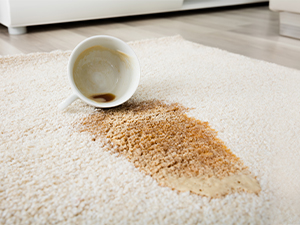Dye stain? No worries. Dyes can be removed from carpet.
Dyes are found in many foods, drinks, and other items, such as magic markers, health and beauty products, cleaning solutions, and decorative items. When dyes end up on your carpet or upholstery, they can be difficult to remove if improper methods are employed. Here are our PRO tips for getting dye stains out.
Blot. Blot. Blot. Then Blot Even More.
Use a white cloth or paper towels to blot as much of the dye as you can. Follow this with putting a few drops of cold water directly onto the dye stain. The water will help dilute remaining dye. Continue with blotting, using a clean section of the cloth or towel each time. Do not rub! Just blot, drip a little water, and blot some more, over and over until no more of the stain is transferring to the cloth or towel.
IMPORTANT!
Don’t forget to test: Of course, your stains don’t always cooperate by appearing in inconspicuous areas, but do keep in mind that it is always recommended that you first test any cleaning solution on a portion of carpet or upholstery that is out of the way, such as a closet or the under side of furniture. Do not use these methods on wool, leather, or silk carpeting or rugs.
The following methods are great for dyes and a host of other tough stains. You will likely need to repeat the process several times to completely remove the dye. Stain removal takes patience and persistence.
The Dish Soap and White Wine Vinegar Solution Method
- Pour two cups of warm water into a bowl. Stir in a tablespoon of white vinegar and another tablespoon of dishwashing liquid.
- Dip a sponge into the bowl and wring out well. Then begin applying the solution directly onto the dye stain. You should see immediate lifting of the stain, but continue blotting until the stain has lifted completely.
- Follow with blotting the area with clear water, then blotting dry with a clean white towel or paper towels.
Peroxide and Dish Detergent Solution Method
- Pour two cups of warm water into a bowl. Stir in half of a cup of 3% hydrogen peroxide and a tablespoon of dishwashing liquid.
- Dip a sponge into the bowl and wring out well. Then begin applying the solution directly onto the dye stain. You should see immediate lifting of the stain, but continue blotting until the stain has lifted completely.
- Follow with blotting the area with clear water, then blotting dry with a clean white towel or paper towels.
OxiClean™ Carpet & Area Rug Stain Remover
- Spray enough of the product to saturate the dye stain.
- Allow the product to dwell for 10 minutes.
- Blot the area dry with a clean white towel or paper towels.
- Follow with blotting the area with clear water, then blotting dry with a clean white towel or paper towels.
Let your carpet and upholstery cleaning PRO help: On your next scheduled cleaning, show your technician the area. Any remaining stain residue can be treated and cleaned.
This article is one of a series of articles written and published on behalf of Surface Care PROS Partners.



